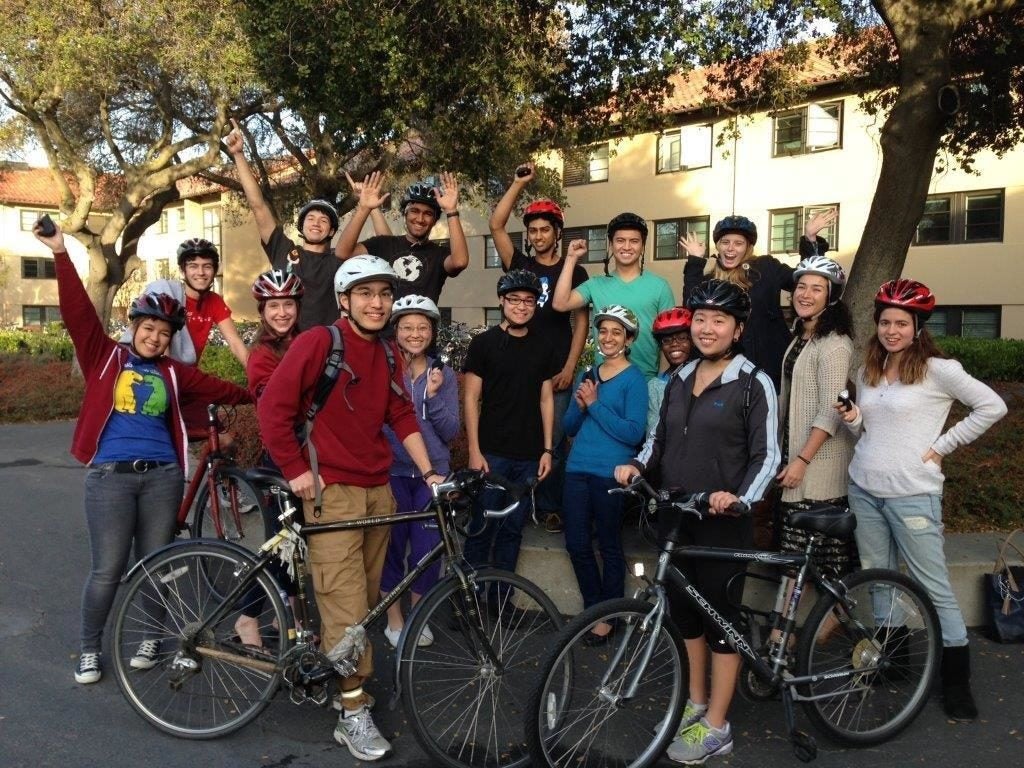Five answers to questions about bike safety
There are an estimated 13,000 bicyclists pedaling around on the Stanford campus each day, creating an abundance of opportunities for cyclists to cross paths with fellow cyclists, motor vehicles, pedestrians—and even stationary objects. Stanford bicycle program coordinator Ariadne Delon Scott talks about what parents ought to know about bike safety at Stanford.
What is the one bike safety mantra parents should tell their students?
Wear a bike helmet for every ride! Students see themselves as invincible. They think a bike crash won’t happen to them. Many don’t recognize that a helmet can save their life and brain function. We’ve heard students who have survived a crash say they wish they were wearing a helmet or they are grateful that there was a helmet between their head and the pavement.
In surveys we’ve done, students say they don’t like wearing helmets because it flattens their hair, none of their friends are wearing helmets, they think they are careful and unlikely to get in an accident and they find helmets inconvenient.
To overcome these barriers and to help Stanford parents encourage their students to commit to bike safety, we are offering a prize drawing for students who take Stanford’s bike safety pledge from now through January. The prize is a free bike tune-up and bike safety kit, which includes a helmet and bike lights. Encourage your student to pledge.
What kind of bike accidents can occur on the Stanford campus?
A good example is Kali Lindsay. During her sophomore year, she crashed while on her way to an appointment with a tutor. She wasn’t wearing a helmet. She recalled getting out of bed, and the next thing she remembered was her parents coming to the hospital around 2 a.m., more than 12 hours later.
Witnesses said she fell from her bike and hit her head on the right temple. She sustained an epidural hematoma, an injury involving bleeding between the skull and brain. The injury caused initial short-term memory loss and dizziness, which prevented her from reading for almost two months, forcing her to take the rest of the quarter off. When she returned to Stanford, she actively encouraged others to wear their helmets.
The chief of trauma and critical care surgery at Stanford spoke to students and told them that that if you look at people who get a head injury riding a bike, 98 percent weren’t wearing a helmet. Wearing a helmet reduces the risk by 85 percent. He also said that you’re 20 times more likely to die with a head injury. Ruptured spleens, ruptured diaphragms, broken legs, broken arms—these can all be fixed. We can’t fix the brain.
What are other bad bike habits you see among students?
Bicyclist distraction is a major cause of crashes—talking on a cell phone, texting, drinking coffee, listening to music. We’ve even seen students doing a combination of these things!
The Department of Public Safety recommends that students be alert, focused and predictable when riding. Here are the types of citations they issue most often.
Top three bicycle violations at Stanford:
• Not stopping at stop signs
• Not using a front bike light after dark
• Having both ears covered while riding, typically with phone or music earbuds.
Parents can help students avoid citations and crashes by encouraging them to learn and follow the rules of the road. Just as motorists stop at all stop signs, use headlights and tail lights, and “drive” on the right side of the road, cyclists also must follow the same rules.
What programs does your office offer?
We have many. In fact, the League of American Bicyclists has recognized Stanford as a Platinum Bicycle Friendly University, the highest designation. Here are some examples:
• In partnership with the Campus Bike Shop, we offer quality bike helmets for just $25, with additional discounts or free helmets subsidized by campus departments.
• We have bike repair clinics and free bike safety repair stands throughout campus. We also do a lot of outreach in dorms and at events throughout campus in which we share the rules of the road that are mandatory for bicyclists under the California Vehicle Code.
• For bicyclists who are cited, we offer a one-time option to attend a free bicycle safety class in lieu of paying the fine.
I encourage parents to visit our website to learn more.
What can parents do to help?
Parents can help their students realize the potential consequences of not wearing a bike helmet. Tell your children that you love them and do not want to see them hurt or needing to leave school due to a bicycle injury. It can work. One student said his motivation for wearing a bicycle helmet is that he doesn’t want to put his parents through the pain of losing him or caring for him if he were to be in a bicycle crash.
If your child does wear a helmet, encourage him or her to convince friends to wear a helmet. We know from our surveys that peer-to-peer influence is the most effective in changing their behavior.
Parents can contact me at adscott@stanford.edu.
Learn more:
• Stanford is a Platinum Bicycle Friendly University
• Bike Questions and Answers
• Love Your Brain

